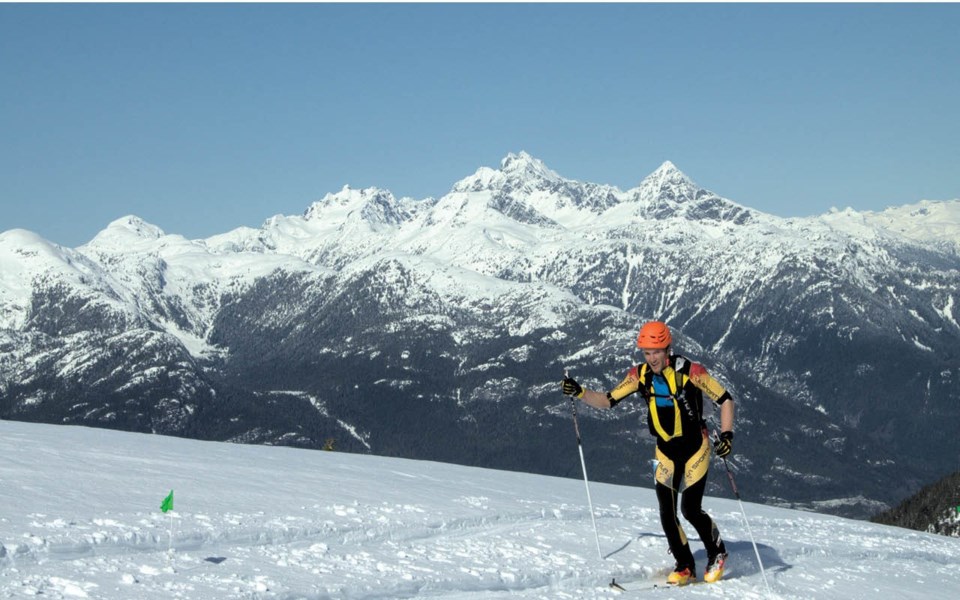My skis shuffle ahead on the skin track in step with the rhythm of my breathing. My face snarls, widening my nostrils to allow more flow of oxygen to my overworked lungs. Lactic acid feels like it's dripping off my quads and triceps, but I know it's just sweat trying to regulate my temperature on a sunny March day.
I'm loving every minute of this madness.
I'm competing in the Ski to Sky Ski Mountaineering Race in Squamish. For the uninitiated, ski mountaineering (or "skimo") events are mass-start, ski-touring races with uphill (touring) and downhill (skiing) segments. They are very popular in Europe and have a niche—albeit rapidly growing—following in North America. Up here in Canada they are more common in the B.C. and Alberta Rockies, but Squamish resident Eric Carter is trying to change that.
"It's strange that we don't have more (skimo) races here on the Coast, most of them take place in the Interior," says Carter, the organizer of today's race and four-year member of the US Ski Mountaineering Team. "You look at somewhere like Colorado and it's crazy how popular it is. I think given how good the snowpack and terrain is here on the Coast, people are more inclined to just go skiing instead of spending the day racing up and down a ski run. That was one of our goals making this race entirely in the backcountry; we wanted to have just as much fun in this race as you would on a day of ski touring."
To grow the niche of skimo racing in Vancouver and the Sea to Sky, Carter says it isn't necessarily about courting the hardcore ski tourers, but the competitive summer fitness crowd (such as mountain-trail runners) who get "stranded in the valley bottom" during the winter. That said, the Ski to Sky skimo race was designed to be accessible to ski tourers curious about racing with an option to enter the short-course variation (900 to1,000 metre ascent) or the full course (1,300 to1,400 m ascent).
At the mandatory pre-race briefing on Saturday morning March 10, Carter commands the attention of the roughly 70 racers crammed into the Basecamp Cafe at the base of the Sea to Sky Gondola. He explains the rules; what equipment everyone needs to be carrying, when it's appropriate to pass someone and that if a fellow competitor is in distress, it's our responsibility as racers to assist them. Carter also walks us through the GPS-marked course and photo slides, highlighting the junction points, creek crossings and heavily treed areas on the lower-ski segment.
About 90 minutes later, up at the start area adjacent to the gondola's top station, racers from all walks of experience mill about. There's the serious, spandex-clad, skinny-ski donning elites. There's folks on fat skis and AT bindings, here more for an experience with their friends rather than trying to win anything. The one lone splitboarder is already receiving kudos from everyone around him.
The cowbell for the pre-race transceiver check sounds and we line up in self-seeding order. Spandex in front, party in the back. I find my place in the middle, correlating my appropriate starting spot with the carbon fibre content of my gear relative to others. It's a Le Mans-style start; we have to run the first couple hundred metres in boots porting skis in hand. The horn signals go and we're off.
The warming temperatures led organizers (advised by Altus Mountain Guides) to move the top transition slightly lower. There's no complaints as we rip skins and descend the powder meadow below. Another quick transition followed by a short climb and I launch into Pillow Gully. My alpine skiing stamina finally makes itself useful and I overtake a couple of people heading into the thicker trees. Bootpacking back up to the road, the short-course competitors peel off to the finish line while I rejoin the long-course masochists. I repeat the second loop, somehow in a good place mentally and physically despite the exhaustion. Those energy jubes in my pocket taste like heaven.
Back at the road for the second time, the marshals direct me for the final five-kilometre skate back to the gondola. I tuck on the downhill sections, maintaining as much momentum as possible into the slight uphill skates. My composure is now lost, grunting my way up the trail knowing I'm so close to the end. I round a corner and hear the finish area cowbells, sprinting as fast as I can before collapsing over the line. I manage seventh place in my division and 18th overall, not bad given my training for this event consisted of simply ski touring a few days a week.
After the sold-out race wraps up, I ask Carter about why people like to suffer on their skis in events like this.
"In ski mountaineering you're not restricted to that groomed track. It's a combination of fitness and freedom—where combined with lighter gear—you can go anywhere pretty fast."
Fitness and freedom. Two things I can get behind.
Vince Shuley will return to Ski to Sky in 2019. He was implored to mention that this event raised more than $800 in donations for Squamish SAR. For questions, comments or suggestions for The Outsider email vince@vinceshuley.com or Instagram @whis_vince.




